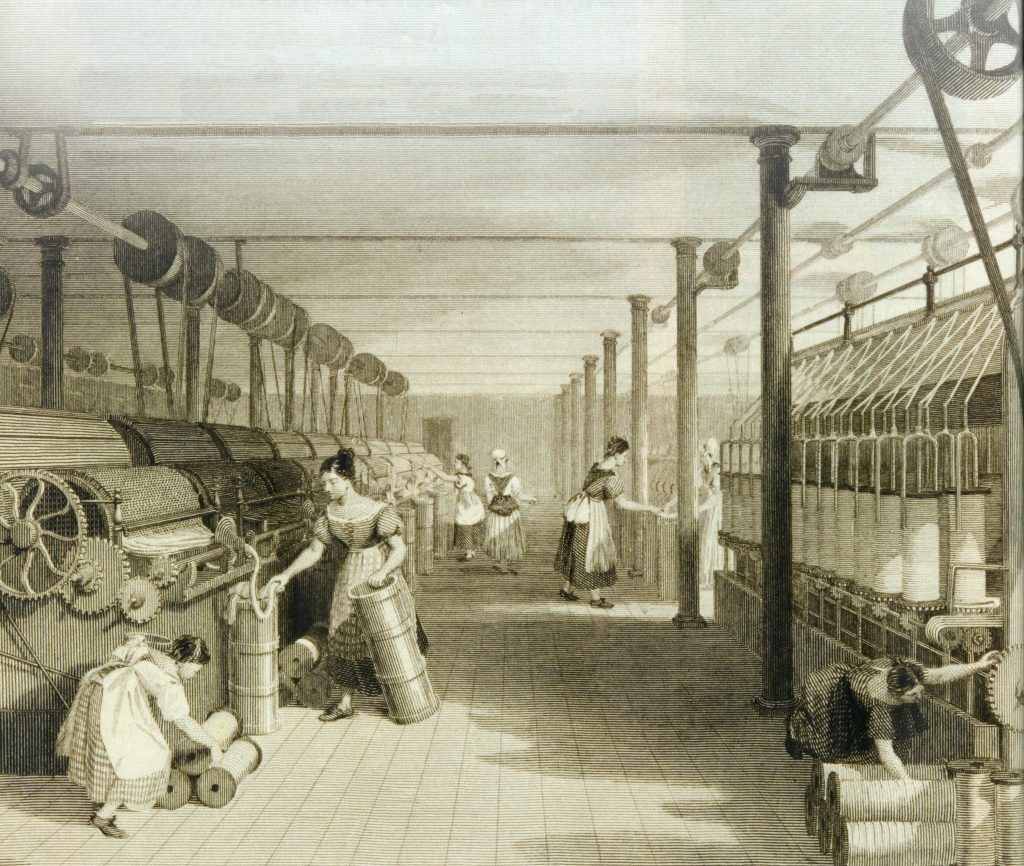Children today spend five days a week going to school for eight hours. During the first half of the nineteenth century in Britain, this was not the case. Instead, children even as young as five or six would toil all day long in factories or in mines. They had no breaks, no time off, and no schooling. Their work often led to horrible accidents, children being injured for life, and children left without an education.
Children laboring, of course, did not start with the British Industrial Revolution. It had been a normal part of life in Europe since the middle ages, when children helped their parents on farms and with household work. The people’s perception of this work, however, changed during the Industrial Revolution, since that is when people began to see this new kind of labor, factory labor, as an injustice and even criminal.1
The Industrial Revolution began in Britain during the 1780’s and rapidly changed the work process and the social relations of work. Prior to the Industrial Revolution, most people worked directly in the production of food, usually as farmers on their own farms. When textile factories began forming in the new factory cities, instead of working on their farms and making what their family needed, people left their farms and moved into the factory cities to make a living. Factory conditions of work, however, were far different from the work rhythms of farm life. In fact, they were brutal in comparison. Factory workers would typically put in between 12 and 16 hour days, working for meager wages. The machines they attended were dangerous, and the workers were often on their feet throughout the day, with perhaps a half-hour break for meals. Among these workers were children, many of whom were as young as five or six years old. Children were valued as workers for their small stature and ability to climb into small places and do things that adults often could not do. This often resulted in mutilation and the loss of appendages for many of these children.2
Children were also valued as workers by the factory owners because of the low wages that they were paid. Men were paid the most in factories, followed by women and then children. These wages, however small, were needed by the families of these children simply to survive. The parents often sent their children out to work to help pay for rent, food, and otherwise help make ends meet.3
One reason that the British public became outraged by child labor practices was the fact that children in factories were not receiving an education. Horace Mann, an American educational reformer, stated:
No greater calamity can befall us as a nation than that our children should grow up without knowledge and cultivation. If we do not prepare them to become good citizens, develop their capacities, enrich their minds with knowledge, imbue their hearts with a love of truth and all things holy, then our republic must go down to destruction as others have gone before it.4
This represents the thoughts of the British at the time, which was being echoed in the United States during its own industrial revolution. People wanted to ensure the future of their nation, which starts with the young. They believed that children should attend school for at least a while.5 This led to several laws being passed to raise the legal age of work.
In 1833, the British Parliament passed the Regulation of Child Labor law to help improve the working conditions for children in factories. The Law limited the age of workers, saying that they had to be older than nine with an age certificate to prove it, and that children 9-13 could not work for more than nine hours a day. Additionally, children 13-18 were not permitted to work longer than twelve hours a day. Along with these work-hour restrictions, the law also made school attendance a two-hour requirement, and said that children could not work at night. Fines for breaking these rules were small, however, so they were frequently violated, often with impunity.6

Many other pieces of legislation were also passed to place limits on the gender, hours, and ages of workers. The Mining Act of 1842 prevented women and girls from working in mines, and the Ten Hours Bill of 1847 set ten as the maximum number of daily working hours for women and children. This act was hated by factory owners because they believed it would hurt the textile industry’s competitiveness worldwide. After these bills, others followed to ensure their effectiveness, and to ensure that they would be properly implemented.7
By 1900, the minimum working age had been raised to twelve years of age and child labor had decreased drastically in Great Britain. However, the introduction of legislation against child labor provoked its share of protests as well. Because of these protests, Parliament established commissions to collect evidence of abusive practices. These were called the Blue Books or Sadler Reports. They interviewed children, parents, factory workers, owners, and even doctors on the condition of children in textile factories. Unsurprisingly, the reports uncovered a range of serious abuses by factory owners and overseers. Unfortunately, most critics just said that the claims were exaggerated in order to continue their money making practices.8
The legislation surrounding the British Industrial Revolution had become very effective by 1900, and child labor and its accompanying abuses had decreased dramatically. By 1900, most children were attending school instead of working in factories. The laws passed finally added up to changing British child labor to being closer to what we see today, a mostly child-free labor system, with children going to school and adults having regulated working hours.
- World History Encyclopedia, 2011, s.v. “Child Labor and Child Labor Laws in Early Industrial Great Britain.” ↵
- James D. Schmidt, “Broken Promises: Child Labor and Industrial Violence,” Insights on Law & Society, no. 3 (Spring 2010): 14–17. ↵
- Robert Whaples, “Hard at Work in Factories and Mines: The Economics of Child Labor during the British Industrial Revolution,” Business History Review, no. 2 (2001): 429. ↵
- Friends’ Intelligencer vol. 28 no. 1 (1871): 336. ↵
- James D. Schmidt, “Broken Promises: Child Labor and Industrial Violence,” Insights on Law & Society, no. 3 (Spring 2010), 14–17. ↵
- Great Britain, “Factories Regulation Act” (1833). ↵
- Steven Toms and Alice Shepherd, “Creative Accounting in the British Industrial Revolution: Cotton Manufacturers and the ‘Ten Hours’ Movement,” MPRA Paper, No. 51478 (2013), 6-8. ↵
- World History Encyclopedia, 2011, s.v. “Child Labor and Child Labor Laws in Early Industrial Great Britain.” ↵



141 comments
Marlene Lozano
I can’t imagine a five or six-year-old child working in a factory to help support the family and not being able to have an education. After reading this article it opens my eyes to how different today’s society is from back then. I’m glad they realized how important education is for kids to have because they are the future of the nation.
Maria Esquivel
This article was very informative and provided many details. I could not imagine having to work at such a young age and missing out on my childhood by doing adult labor. These children were being paid very little but had to endure so much at such a young age, some even losing their lives. These children were making a living but not a life.
Tyler Thompson
I was shocked to read that children were forced to undergo such harsh and intensifying labor. I was very unaware, and had always thought that education was the primary option for children. It was very nice to learn too however how overtime, the government started to pass laws that disallowed women and girls to work in the mines to children as a whole who were then being put into schools.
Dayna Valdez
Many times, you don’t picture a 5 year old working to help their family out and it is crazy to think that at one point it was normal. The amount of work they put in and the little amount they get paid is incredibly saddening. The article also gives the readers to see how much the world and work labors have progressed throughout the years.
Brianda Gomez
Reading this article was heartbreaking! I cannot believe how children were living in the 1780s. After reading this, and realizing how our world is very different to how it was before. Thanks to all of the protests and acts, children were no longer exposed to the dangers of working in factories at such a young age. Children should be able to have a good childhood while it lasts.
Josselyn Arrieta-Meraz
It’s hard to imagine such young children working and being providers to their families at such a young age. A fact mentioned in the article stating how these children were paid so little sadly did not surprise me at all. Women who were adults and more knowledgeable were still being threaded poorly, what was expected for these children? I am glad that the perception of education started to be seen in terms of the future, because it is simply true. We need to educate the young, in order to hope for a better future. Such a good article and interesting read!
Angela Rodriguez
It is amazing to see how long time has passed. Children growing up during the Industrial Revolution era were working in the factories while in children growing up in today’s society are glued to video games and electronic devices. I could never imagine as a kid, having to work in harsh factory conditions. I am grateful for the laws that passed regarding the minimum age you can start working.
Osman Rodriguez
I enjoyed reading this article. Especially after reading a different one that dealt more with child labor in coal mines. Reading about how much society and the work force has progressed, makes me happy. I can’t imagine seeing kids as young as 7 years old working such dangerous equipment/ machinery and extreme amount of hours. Of course, back then child labor was most likely necessary, but just because it was, does not mean it is right.
Joel Gracia
This article fills me with gratitude and reminders of the luxuries provided to us in this current century. It is terrible that the economy in that setting was so bad that it was indirectly sustained by child labor. I knew that child labor existed, but I had never thought of the fact that it took the place of school. I will be forever grateful that the youth were finally invested in by being educated so that they were able to make larger contributions to society later on.
Amanda Figueroa
This article explained in great detail the horrible conditions that children suffered when the industrial revolution began. Although parents knew the state that the children were working in, it was necessary for them to work to have enough to support the family. However, I am glad that the British public knew how wrong and unethical this was and took some action.